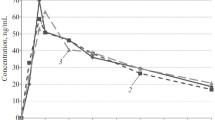Summary
Nine healthy, male subjects received controlled-rate i.v. infusions of a new formulation of pirenzepine to produce constant plasma levels of 40 ng/ml and 105 ng/ml. They also received stepped infusions resulting in plasma levels of 20, 40, 80 and 40 ng/ml for defined periods.
Peptone-stimulated gastric acid and volume secretion and near point vision decreased dose dependently, whereas gastric acidity was unchanged. There was a significant correlation between inhibition of gastric acid secretion and the pirenzepine concentration in plasma and in gastric juice. During the stepped i.v. infusion, changes in near point vision were closely related to the plasma drug concentration. Antimuscarinic side-effects occurred more frequently when the plasma drug level was high.
Overall, there was a close relationship between the plasma concentrations and the effects and side-effects of pirenzepine. Its gastric inhibitory action was characterized only by a reduction in gastric volume secretion. Increasing plasma concentrations during the first days of treatment may be essential for its efficacy as an antiulcer drug.
Similar content being viewed by others
References
Becker HD (1978) Methodischer Fortschritt in der Funktionsdiagnostik des Magens; Magensekretionsanalyse, intragastrale Titration, endokrine Provokationstests. Z Gastroenterol 16: 118–125
Bertoglio S, Anfossi A, Arnulfo G, Valentini P, Berti Riboli E (1982) Effect of pirenzepine on L-amino acids stimulated gastric acid secretion and serum gastrin levels in peptic ulcer disease in men. Scand J Gastroenterol 17 [Suppl 72]: 179–184
Bodemar G, Walan A, Lundquist G (1978) Food-stimulated acid secretion measured by intragastric titration with bicarbonate in patients with duodenal and gastric ulcer disease and in controls. Scand J Gastroenterol 13: 911–918
Bozler G, Hammer R (1980) An international pharmacokinetic study on pirenzepine following a single oral dose. Scand J Gastroenterol 15 [Suppl 66]: 27–32
Carmine AA, Pakes GE, Brogden RN, Heel RC, Speight TM, Avery GS (1985) Pirenzepine. A review of its pharmacology and therapeutic use in peptic ulcer disease and other allied diseases. Drugs 30: 85–126
Ciba-Geigy (ed) (1977) Wissenschaftliche Tabellen Geigy, 8th edn. Ciba-Geigy, Basle, Switzerland
Dent J (1984) Muscarinic receptors and esophageal motor function. Trends Pharmacol Sci [Suppl January]: 82–86
Etienne À, Fimmel CJ, Bron BA, Loizeau E, Blum AL (1985) Evaluation of pirenzepine on gastric acidity in healthy volunteers using ambulatory 24-hour intragastric pH-monitoring. Gut 26: 241–245
Fordtran JS, Walsh JH (1973) Gastric acid secretion rate and buffer content of the stomach after eating: Results in normal subjects and in patients with duodenal ulcer. J Clin Invest 52: 645–657
Fritsch WP, Scholten T, Müller J, Hengels K-J, Hanrath K-D (1982) The effect of a 100 mg pirenzepine-treatment on acid secretion and serum gastrin. Scand J Gastroenterol 17 [Suppl 72]: 173–177
George JD (1968) New clinical method for measuring the rate of gastric emptying: the double sampling test meal. Gut 9: 237–242
Hammer R, Koss FW (1979) The pharmacokinetic profile of pirenzepine. Scand J Gastroenterol 14 [Suppl 57]: 1–6
Holford NHG, Sheiner LB (1981) Understanding the dose-effect relationship: Clinical application of pharmacokinetic-pharmacodynamic models. Clin Pharmacokinet 6: 429–453
Jaup BH (1982) Clinical pharmacology of selective antimuscarinic compounds. In: Dotevall G (ed) Advances in gastroenterology with the selective antimuscarinic compound-pirenzepine. Excerpta Medica, Amsterdam Oxford Princeton, pp 7–12
Jaup BH, Stockbrügger RW, Dotevall G (1980) Comparison of the action of pirenzepine and l-hyoscyamine on gastric acid secretion and other muscarinic effects. Scand J Gastroenterol 15 [Suppl 66]: 89–94
Konturek SJ, Biernat J, Oleksy J (1974) Serum gastrin and gastric acid response to meals and various pH levels in man. Gut 15: 526–530
Konturek SJ, Obtulowicz W, Kwiecien N, Dobranska M, Swierczek J, Kopp B, Oleksy J (1980) Effects of pirenzepine and atropine on gastric secretory and plasma hormonal responses to shamfeeding in patients with duodenal ulcer. Scand J Gastroenterol 15 [Suppl 66]: 63–69
Kuhn E, Skala I, Fucikova E, Slygin GK, Vasilevskaja LS (1977) The effect of gastrozepin — A new preparation of antiulcerative activity on the gastric secretion of human beings and dogs. Therapiewoche 27: 1620–1629
Londong W (1982) Anticholinergics for peptic ulcer — a renaissance? Hepatogastroenterology 29: 40–46
Londong W, Londong V, Cederberg C, Steffen H (1983) Dose-response study of omeprazole on meal-stimulated gastric acid secretion and gastrin release. Gastroenterology 85: 1373–1378
Londong W, Londong V, Meierl A, Voderholzer U (1987) Telenzepine is at least 25 times more potent than pirenzepine — a dose response and comparative secretory study in man. Gut 28: 888–895
Londong W, Londong V, Prechtl R, Weber Th, Werder K (1980) Interactions of cimetidine and pirenzepine on peptone-stimulated gastric acid secretion in man. Scand J Gastroenterol 15 [Suppl 66]: 103–112
Londong W, Londong V, Ruthe C, Weizert P (1981) Complete inhibition of food-stimulated gastric acid secretion by combined application of pirenzepine and ranitidine. Gut 22: 542–548
Loweg C, Becker HD, Degenhardt D (1982) Untersuchungen zur intragastralen Titration beim Menschen. Z Gastroenterol 20: 305–313
Mahachai V, Reilly P, Thomson ABR (1984) Comparative effects of pirenzepine alone and in combination on 24-hour gastric acidity in duodenal ulcer disease. Clin Ther 7: 98–111
Pancorbo S, Bubrick MP, Chin TWF, Miller KW, Onstad G (1984) Cimetidine dynamics after repeated intravenous injection. Clin Pharmacol Ther 35: 50–54
Scholten T, Fritsch W-P, Müller J-E, Hengels K-J (1982) The inhibition of vagal stimulated acid secretion by pirenzepine and cimetidine. Scand J Gastroenterol 17 [Suppl 72]: 169–171
Tanswell P, Kasper W, Zahn G (1986) Automated monoclonal radioimmunoassay for pirenzepine, a selective muscarinic receptor antagonist, in plasma and urine. J Immunol Methods 93: 247–258
Weichselbaum TE (1946) An accurate and rapid method for the determination of proteins in small amounts of blood serum and plasma. Am J Clin Pathol 16: 40–49
Williams JG, Deakin M, Ramage JK (1986) Effect of cimetidine and pirenzepine in combination on 24 hour intragastric acidity in subjects with previous duodenal ulceration. Gut 27: 428–432
Author information
Authors and Affiliations
Rights and permissions
About this article
Cite this article
Londong, W., Londong, V., Federle, C. et al. Pharmacokinetic and pharmacodynamic studies in man simulating acute and chronic treatment with oral pirenzepine. Eur J Clin Pharmacol 36, 369–374 (1989). https://doi.org/10.1007/BF00558297
Received:
Accepted:
Issue Date:
DOI: https://doi.org/10.1007/BF00558297




